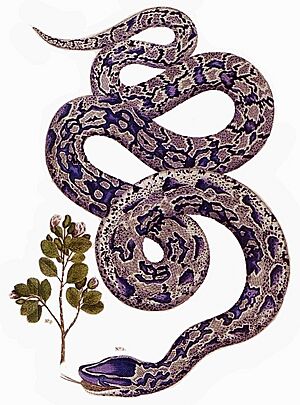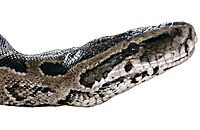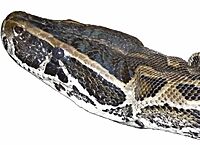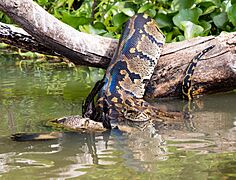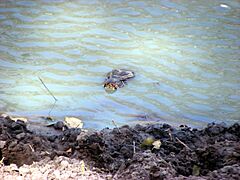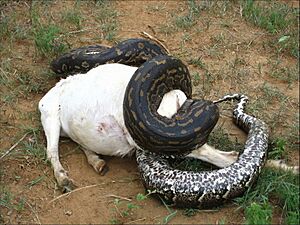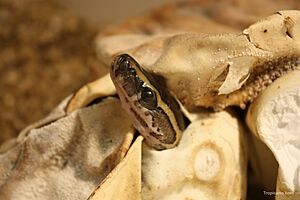Central African rock python facts for kids
Quick facts for kids Central African rock python |
|
|---|---|
 |
|
| Adult female (note the thick body) | |
| Conservation status | |
| Scientific classification | |
| Genus: |
Python
|
| Species: |
sebae
|
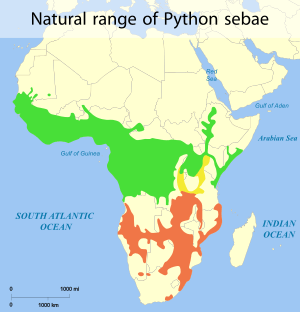 |
|
|
Range of Python sebae Range of Python natalensis Range of hybrids |
|
The Central African rock python (Python sebae) is a very large snake found in sub-Saharan Africa. It is a type of constrictor snake, meaning it squeezes its prey to kill it. This snake is one of the biggest snakes in Africa and among the largest in the world.
These pythons can grow to be very long, sometimes over 6 meters (20 feet)! They live in many different places, from forests to areas near deserts, but they usually like to be close to water. During the dry season, they become less active. Central African rock pythons eat many kinds of animals, even large ones like antelopes or sometimes even crocodiles. Unlike many other snakes, the female python stays with her eggs to protect them. She might even guard her babies for a short time after they hatch.
Even though these snakes are big and can seem scary, they are not venomous. They rarely attack humans. While they are not endangered, their homes are shrinking, and sometimes people hunt them. In some parts of Africa, people even eat them.
Contents
About the Central African Rock Python
The Central African rock python belongs to a group of large snakes called Python. These snakes are found in warm, wet areas of Asia and Africa.
A German scientist named Johann Friedrich Gmelin first described this snake in 1789. The name Python comes from an old Greek word for a huge snake in Greek myths. The second part of its name, sebae, is a Latin version of the last name of a Dutch zoologist, Albertus Seba.
What Does It Look Like?
The Central African rock python is Africa's biggest snake. It is also one of the largest snakes in the world. Adult pythons are usually about 3 to 3.5 meters (10 to 11.5 feet) long. Some very large ones can be over 4.8 meters (16 feet). There are even stories of pythons over 6 meters (20 feet) long, but these are rare. These snakes are quite heavy, often weighing 55 to 65 kilograms (120 to 140 pounds). Some extra-large ones can weigh over 90 kilograms (200 pounds).
The size of these snakes can be different depending on where they live. In places with many people, they tend to be smaller. In areas with fewer people, like Sierra Leone, they can grow much larger. Female pythons are usually bigger than males.
The python's body is thick and covered with colored spots. These spots often connect to form a wide, uneven stripe. The colors can be brown, olive green, chestnut, or yellow. The underside of the snake is white. Its head is shaped like a triangle. On top of its head, there is a dark brown mark that looks like a spearhead, outlined in yellow. It has many sharp, curved teeth. There is also a special triangular mark just below its eye.
Like all pythons, the Central African rock python has small, smooth scales. Around its lips, it has special pits that can sense heat. These pits help the snake find warm-blooded prey, even when it's dark. Pythons also have two working lungs, which is different from many other snakes that only have one. They also have small bumps called pelvic spurs. These are thought to be tiny leftover parts from when snakes had legs a very long time ago.
There are two main types of African rock pythons: the Central African rock python (P. sebae) and the Southern African rock python (P. natalensis). Here are some ways to tell them apart:
- The Southern African rock python usually has duller colors.
- P. sebae has two clear light lines that run from its nose, over its eye, to the back of its head. These lines are much fainter in P. natalensis.
- The Central African species has bigger scales on its head.
- P. natalensis is typically smaller, reaching about 2.8 to 4 meters (9 to 13 feet). P. sebae is usually 2.7 to 4.6 meters (9 to 15 feet) long.
- The dark patch around the eye is lighter and narrower in P. natalensis. This makes it look more like a dark stripe instead of a yellow stripe.
Where Do They Live?
The Central African rock python lives almost everywhere in sub-Saharan Africa. You can find it from Senegal in the west to Ethiopia and Somalia in the east. It also lives south to Namibia and South Africa. P. sebae is found in central and western Africa. P. natalensis lives more in eastern and southern Africa, from southern Kenya to South Africa.
Sometimes, these pythons are found in places they don't naturally belong. For example, in 2009, a Central African rock python was seen in the Everglades in Florida, USA. People worry that it might become an invasive species there, like the Burmese python already is.
These snakes live in many different places. They can be found in forests, savannas (grasslands with scattered trees), open grasslands, and even rocky areas. They especially like places with water, such as the edges of swamps, lakes, and rivers. They can also live in areas changed by humans, like farms, especially sugar cane fields.
- Rock python habitats
-
Central African rock python, Senegal National Park
How They Live and What They Eat
Hunting and Food
Like all pythons, the Central African rock python is not venomous. It kills its prey by squeezing it tightly. After grabbing an animal, the snake wraps its body around it. It then tightens its coils each time the animal breathes out. Scientists believe the animal dies because its heart stops, not just from being crushed or suffocated.
These pythons eat many different animals. They hunt large rodents, monkeys, warthogs, and antelopes. They also eat birds like vultures and bats. Sometimes, they even eat monitor lizards or small crocodiles. In areas near people, they might eat rats, chickens, dogs, and goats. They can even catch fish. Very rarely, they might try to eat the babies of big cats like leopards or lions, or young hyenas. However, adult big cats can easily scare off or kill pythons.
In 2017, a 3.9-meter (12-foot 10-inch) python was filmed eating a large male spotted hyena. This showed that these snakes can hunt and kill animals that are bigger and more dangerous than people thought. The biggest meal ever recorded for any snake was when a 4.9-meter (16-foot) African rock python ate a 59-kilogram (130-pound) impala.
Having Babies
Central African rock pythons usually have babies in the spring. The female snake lays eggs, usually between 20 and 100 of them. These eggs have hard shells and are long. She lays them in places like old animal burrows, termite mounds, or caves.
The female python is a very caring mother. She coils her body around the eggs to protect them from other animals. She might also help keep them warm. The eggs hatch after about 90 days. After the babies hatch, the mother snake guards them for up to two weeks. This is quite unusual for snakes, as most mothers leave their young right after they hatch.
Baby pythons are about 45 to 60 centimeters (18 to 24 inches) long when they hatch. They look almost exactly like the adult snakes, but their colors are brighter. In zoos, these pythons can live for over 12 years.
Pythons and People
Rare Attacks
Attacks on humans by Central African rock pythons are extremely rare. Even though these snakes live in many places where people also live, very few deaths have been confirmed. There are no confirmed reports of a human being completely eaten by one. While very large pythons could potentially eat a small adult human, this is highly unlikely to happen.
- In 1979, in South Africa, a 4.5-meter (15-foot) python killed a 13-year-old boy. The boy died from being squeezed and from internal injuries. An adult man helped, and the python let go of the boy's body.
- In 1999, in Illinois, USA, a 3-year-old boy was sadly suffocated by a pet African rock python that had escaped.
- In 2013, in Canada, two young brothers, aged four and six, were reported to have been killed by a large pet python. The snake's owner was charged with not keeping the boys safe from the snake.
- In 2017, in England, a pet python was found to have killed its owner by squeezing them.
Conservation Efforts
Many people are afraid of large pythons and might kill them if they see them. In some areas, Central African rock pythons are hunted for their skin, which is used to make leather. Because of these threats, the snake is listed as a "Near Threatened" species. This means it could become endangered if its situation doesn't improve. People also collect them to sell as pets, but these snakes are not usually good pets because they get very big and can be unpredictable.

Some of the places where Central African rock pythons live are also being destroyed. For example, in southeastern Nigeria, forests are being cut down for oil exploration.
Even with these problems, the Central African rock python is still common in many parts of Africa. It can even adapt to areas where humans have changed the land, as long as there is enough food. However, the population of these snakes in West Africa has gone down a lot. This is mainly because they are hunted for food and leather. Their numbers have dropped by more than 60% in some areas over the last three generations.
To help protect them, the Central African rock python is listed on Appendix II of CITES. This means that international trade of these snakes should be carefully watched and controlled. This helps protect wild populations from being over-collected for pets and skins. These snakes also live in protected areas, like the Serengeti National Park in Tanzania.
In the Florida Everglades, where the Central African rock python is an invasive species, it is not protected. In fact, it is one of the snakes that officials allow people to hunt to try and remove it from the wild. This is because it poses a threat to the native wildlife there.
In Culture
The Luo people of Kenya, who live near Lake Victoria, often think of snakes as bad. However, they have a different view of pythons. They even include pythons in their play songs and sometimes worship them. The Luo call the Central African rock python ng'ielo. In their songs, children make a line and move like a python, singing "ng'ielo jadhogre," which means "python the coiling."
When the Luo worship a python, they call it Omieri. They believe Omieri is a python spirit that returns. This python is seen as a new form of Omieri, who is a goddess of harvest, rain, and good fortune. In 2003, a python believed to be Omieri appeared. This caused a lot of discussion around the world about how it should be treated.



